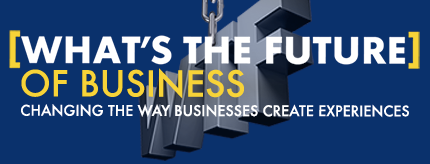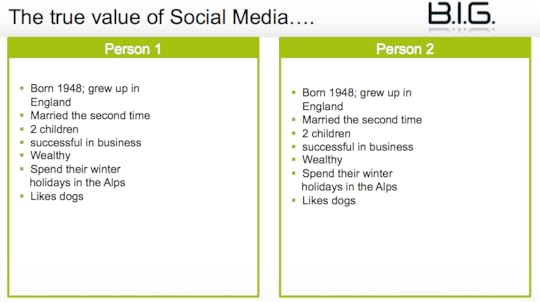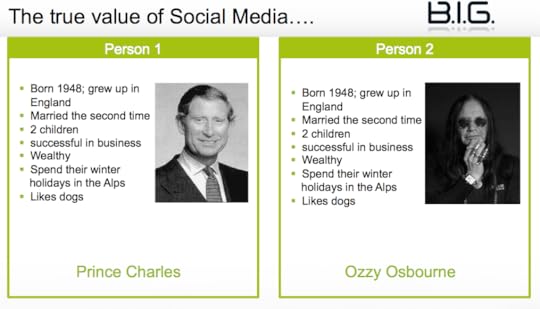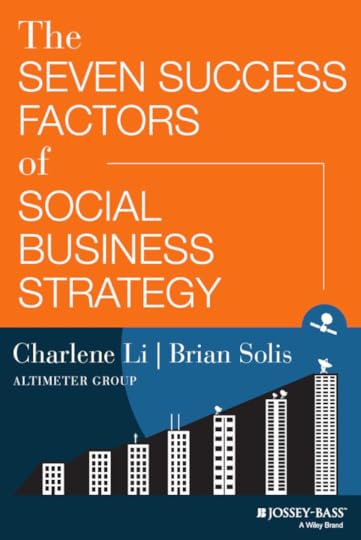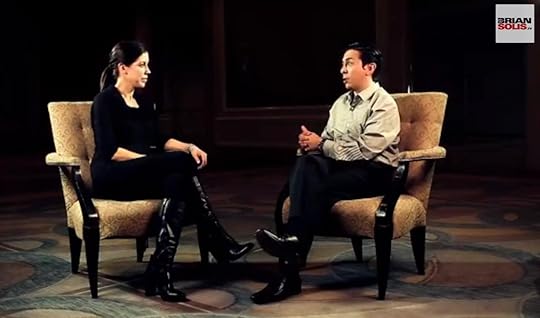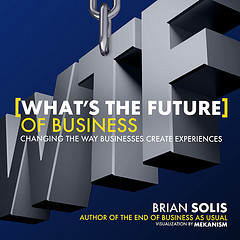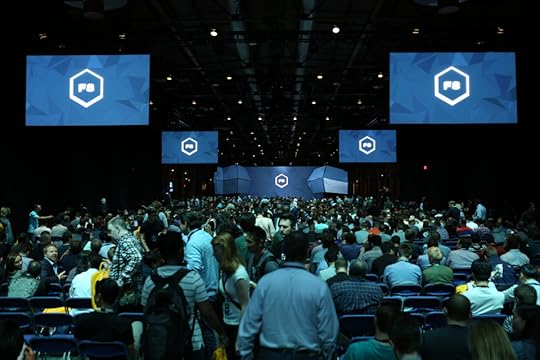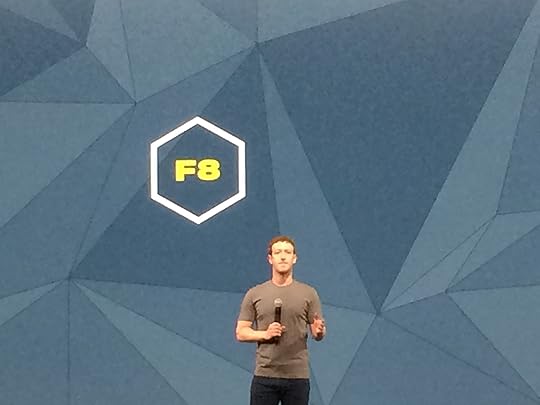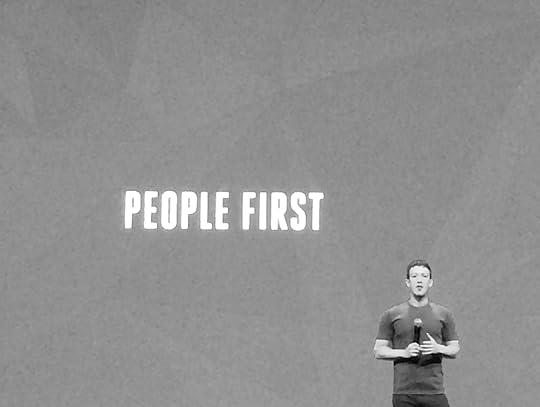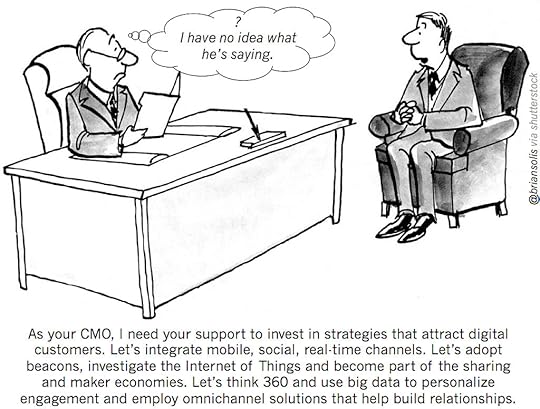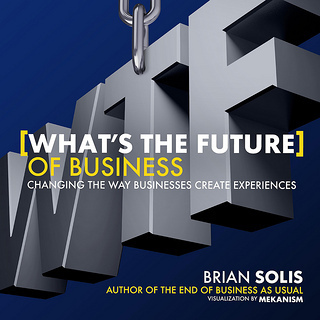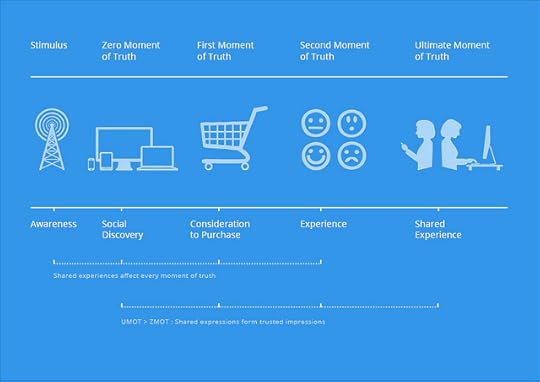Brian Solis's Blog, page 109
June 3, 2014
The Accidental Narcissist and The Future of Customer Engagement
Have you ever noticed that your Facebook News Feed is the digital equivalent to “It’s a Wonderful Life?” Perhaps you’ve liked your Instagram stream to that of “Lifestyles of the Digital Rich and Internet Famous.”
In each network, and across multiple social streams, you’re fed a visual buffet of travel, food, fashion, celebrations, which in assemblage, tell the story of life well lived or at least a life well curated. And at the center of each of these experiences is the person living and sharing them in real time. Every day that passes, it seems that a growing network of our friends, family and colleagues are charmed with this picturesque life.
But who are we kidding? We not only described pretty much everyone in our social networks, but we might as well be talking about ourselves too. It’s a social world after all and shared experiences are the epicenter of a growing majority of engagement. As such, we’re introduced to new law of social physics if you will where for every action there is an equal or greater reaction. The truth is that social sharing is part self-expression and also part provocation. People share to communicate who they are or want to be while concurrently hoping to incite a reaction that validates or substantiates their intended online persona.
This may seem like a personal discussion, but I can assure you that this also has everything to do with your business.
I’d like to officially introduce you to your connected customer. I believe it’s about time we get to know the connected set to better understand how to engage them in social and mobile networks now and throughout the entire customer lifecycle.
It’s All About You and Me…But Mostly Me
If you’re reading this then you’re most likely the very person you’re trying to reach. You’re connected, always on, unabashedly multitasking, and living across multiple screens each and every day. You live a digital lifestyle and without realizing it, you and others like you, are gradually exhibiting slivers of narcissism. Believe me, I say this with the utmost discretion. You can’t help it of course. These networks prompt you to share your world, your way, all day, every day. And each time we do, we contribute to our egosystem where we by default become the center of our own digital universe. Experiences and engagement therefore represent the orbits that bring us together.
Let’s visit planet Facebook and its orbiting moon Instagram for a moment. Facebook is now home to over one billion digital denizens. To put that in perspective, that’s roughly about ~12 percent of planet earth. Instagram is a fledgling digital society in its own right. At 100 million residents and counting, a culture of sharing one’s experiences is further enhanced by the ability to instantly enhance them with a creative filter, broadcast them across multiple networks and earn the attention and reaction of a boundless and seemingly idle audience.
The question is, if everyone is busy sharing content, then who is consuming it? This is also the law of social attraction. It’s a reciprocal relationship where to earn reactions, one must equally or progressively react. How do you do that if the real-time web moves in well, real-time?
The Age of Prevalence
Understanding digital behavior has never known greater importance. It’s evolving and we need to appreciate its velocity and impact. For example, on Facebook, conversations lose momentum in an hour give or take. The reason for this is because people consume until they create. As they create, expectations shift as characteristics of narcissm take over. What about Instagram? Allow me to share some revealing behavioral stats that will make you say, “wow.”
Statigram is a third-party tool that tracks activity Instagram. According to a fascinating article in pdn (Photo District News) written by Kathleen Hay, Statigram tracked the number of photos tagged ‘selfie,’ social slang for self portrait (yes, that’s a thing.) At 11 p.m. PST on December 28th 2012, the number of selfies numbered at a noteworthy 5.5 million. The egostyem wouldn’t be the same without the “me” in social media. At the same time, photos tagged ‘me’ completely eclipsed ‘selfie’ with a staggering 72.6 million self-portraits. Added together, you start to get the picture of just how prominent the egosystem is becoming.
In the article, Hay introduces us to Dr. Jean M. Twenge, Ph.D. Professor of Psychology and author of Generation Me and co-author of The Narcissism Epidemic: Living in the Age of Entitlement. The titles alone convey that connected consumerism is nothing like the conventional customers you once knew. To better understand the crux of selfies and the digital “me”, Twenge explains that at the core of narcissism is this invention or aspiration that people are better or more important than in reality. In the digital realm however, perception is reality.
Agree or disagree, this is your connected customer. And in many ways, you and those you know are among them. Knowing this, it’s time to get some answers. First, how can you re-imagine your engagement strategies to align with and inspire the “me” in social media so that your brand, promise or vision becomes an active part of self-expression? Second, how does or how can my brand evoke an experience that elicits self-expression? Lastly, how will my brand become part of the egosystem and create a gravitational pull for others to orbit?
The answers just might change the way you see and engage your customers.
Connect with me:
Twitter | LinkedIn | Facebook | Google+ |Youtube | Instagram
Superhero Image Credit: Shutterstock
May 28, 2014
Connected Customers are Invisible to Those Who Value Demographics
Why Generation-C requires empathy and personalization not marketing…
In 2012, I spoke at a conference in Amsterdam focused on big data and intelligence to help businesses keep pace with the new generation of connected customers. I remember watching an informative and entertaining presentation by Dr. Peter Gentsch, founder of the Business Intelligence Group (B.I.G.) in Berlin. While this was two-years ago, a lifetime in today’s new media world, I feel his example is still as relevant today as it was then.
On stage, Dr. Gentsch shared an example that demonstrated the importance of understanding interests and behavior in marketing rather than that of traditional demographic profiling. Even though this point was a critical theme in each of my last three books, I’d not found a simple way to communicate the preposterous of generic persona modeling so succinctly as him.
Allow me to share…
The audience was presented with two seemingly similar profiles. Each individual was born in the same year as the other, in the same country. They were both married for the second time with two children. These individuals were successful, wealthy, vacationed in the Alps each winter, and they also shared an affinity for dogs.
Of course, the two individuals profiled simply by demographic data are not at all identical in how any thoughtful business would approach either successfully. Dr. Gentsh then demonstrates the almost comical nature of this comparison by revealing the identity of the two individuals. On one side we see Prince Charles. The other? Ozzy Osbourne. When viewed through this lens, the lush customer landscape we originally envisioned is suddenly not a marketing oasis after all. Traditional marketing as it turns out is becoming a mirage.
Keep calm and carry rock on.
Not that this insight is new or particularly revealing, but it is a sharp reminder that complacency is pervasive in traditional marketing. Regardless of new technologies, social, mobile, big data, et al., we are not unlocking new capabilities. We are in large part, still approaching innovation in customer engagement with a dated or classic mindset.
The days of demographic profiling aren’t completely behind us, but they are limited in overall reach and value.
Context is King! Behavior and Interests Reveal New Opportunities
Many marketers tend to view markets as audiences. Even in a social world, where many businesses are embracing new networks to reach customers, the social graph of these coveted networked relationships is essentially subjected to mass marketing or broadcasting under the illusion of two-way conversations.
As the Cluetrain Manifesto so rightfully proclaimed in 1999, “markets are conversations.”
“A powerful global conversation has begun. Through the Internet, people are discovering and inventing new ways to share relevant knowledge with blinding speed. As a direct result, markets are getting smarter—and getting smarter faster than most companies.”
Not only are markets now conversations, the audience is no longer passive or static. Their attention is no longer described in terms of eyeballs, traffic or time onsite. Audiences are now connected and democratized. The power of influence is shifting where it is not owned but instead shared. We are in fact faced with an informed and connected audience that now has an audience with audiences of its own. We are not just talking to people. We are presented with an opportunity to talk with and through them, activating networks, sparking conversations and engagement, and building relationships that offer mutual value.
This is no longer just about anonymously grouping traditional customers by audience demographics. That was then and it’s a time I’m relieved to see on the cusp of passing. Now, we must embrace connected customers based on digital, social and mobile. Connected customers, or as I refer to them, Generation C, aren’t grouped by age, education, or income. Instead, Gen-C reveals itself as the real people behind the faceless clicks exposing shared behavior and interests. This generation is uniquely visible by the context of the conversations they have, the people they know, the technology they use, the digital and real world places they frequent, and the brands, products, and other lifestyle objects that they socialize with.
It takes a shift in perspective and a new lens to see and appreciate them. If you don’t, they’ll simply evolve while you run in place.
See, Generation-C is by default connected. But it’s more than that. As a result of connectedness, Gen-C becomes empowered. Information is after all, a form of currency and access can contribute ultimately to status and power. As such, connected customers become more demanding. They expect to be heard. They expect personalization. They demand an integrated, frictionless and value-added touch at every stage of the journey, before, during, and after transactions. These discerning customers wish to be valued in both engagement and enchanted through experiences that are bigger and more important than your everyday product, sale, and service.
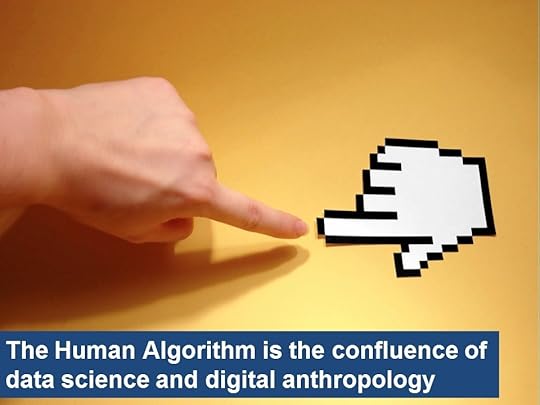
To identify them requires research and empathy. Generation C is not identifiable by demographics or generic personas. Generation C is a lifestyle…it’s everyone who lives a digital life. They’re connected and they’re in control. To evolve takes research that combines data science and digital anthropology.
To discovery them starts with studying more than the networks and technologies they use. Marketers must now partner with research teams to learn about behavior within and around networks, apps and devices. Doing so uncovers interests, preferences, expectations, and destinations. As a result, you are able to see and map out the new customer journey. And, you learn how to do more than just react to actions, sentiment, and trends. You’ll realize how to create meaningful customer journeys that improve experiences in existing and also new touch points…throughout the entire customer lifecycle.
Meet your new customers…Generation-C. You may in fact already be part of this movement. As such, you are the very customer you’re trying to reach.
Connect with me:
Twitter | LinkedIn | Facebook | Google+ |Youtube | Instagram
Faceless image: ShutterStock
May 21, 2014
Improving Customer Targeting and Personalization Through Social Identity
Guest post by Andrew Jones (@andrewjns), analyst at Altimeter Group covering Social Media and Customer Experience
Modern marketing is about more than just informing prospects and customers about products, but building relationships with them. The contextual insight available in social media offers an opportunity to better know and engage audiences with compelling, personalized content and experiences across channels. The following is a condensed excerpt from a forthcoming report.
The Fragmented Customer Journey
The customer journey has become incredibly fragmented, moving across various channels and devices, and saturated with more messages than ever. At the same time, customers have been empowered by new technology, increasingly expecting consistent, personal experiences. As a result, it has never been more necessary—yet also so complex—for brands to target and personalize customer messaging.
So why are marketers still sending untargeted, “batch and blast” emails, serving static web pages, and delivering the same ad to everyone (or just a small handful of segments)?
Lots of Data, Limited Context
With the proliferation of customer data in CRM, eCommerce, web analytics, loyalty programs, and other databases, enterprises have troves of information about their customers. Yet companies often understand customers in the context of their transactions and rarely as individuals. Customer identity today is a shattered mirror, with little pieces of it spread throughout the organization. Customer Service, sales, marketing, and loyalty each see a different piece of the profile. Without the right context, brands will never be able to build good relationships with customers.
The Value of Social Identity
Social media has played a major role in compounding the complexity of today’s customer journey, yet is also laden with customer insights unavailable on other channels. Suresh Vittal of Adobe says that, “Social yields sentiment, preference, and influence in ways that no other data source can.” Social profiles contain demographics, age, geography, affinity, influence, and more, while ongoing social signals can provide insight into a customer’s real-time context and needs.
For the purposes of this blog post, I’ll define Social Identity as, “The information about an individual available in social media, including profile data as well as ongoing social activity.” Social Identity can:
- Enable better targeting and personalization throughout the customer lifecycle
- Help provide consistent customer experiences across channels
- Provide a clear source of social media ROI
- Increase the efficiency of marketing and advertising budgets
Targeting and Personalization
In a recent interview, Jack Krawczyk, Pandora’s director of product management, said:
“Targeting users is basically the currency in data right now. Companies like Pandora and Facebook know users’ names and can track their media consumption or stated preferences across computers, tablets and phones, and have an advantage over companies relying on Web browsing cookies.”
Brands can access many of the same data points today, and those that do can better personalize content:
NFL.com is using social login to allow visitors to register and sign into its website. Not only does NFL.com then personalize the site experience, but it also sends highly personalized emails. For example, it sends offers for personalized jerseys based on a user’s favorite team and last name as their birthday approaches.
Social Media ROI
While the value of social media is typically hard to measure beyond vanity engagement metrics, other channels have metrics directly associated with ROI (e.g. open rates, CTR, downloads). Social Identity can directly impact those metrics:
Cox Media Group is increasing subscription rates by incorporating Social Identity to personalize the website experience, making sure users don’t see the same articles again and see those most related to their interests.
Improving Marketing and Ad Spend
Marketers are spending more on technology every year—especially technology that can engage customers in personal ways at scale, like marketing automation, email service providers, retargeting, and dynamic web content. Social Identity improves value of these tools by improving targeting capabilities:
Interscope Records has seen email open rates increase by over 9x in some cases, by sending customers messaging relevant to the artists they care about, based on their social signals.
In the report, I discuss ways to apply Social Identity throughout the Customer Lifecycle, but I’d like to know: how and when can additional customer insight help you build relationships with your customers? Please let me know in the comments.
Infinity Loop via Shutterstock
May 14, 2014
Q&A: The 7 Success Factors of Social Business Strategy
Last year, my Altimeter Group colleague Charlene Li and I published a series of research reports on the state and evolution of social business. In our research, we discovered that the most advanced businesses shared seven success factors in developing, launching, and measuring social business strategies. Our friends at Jossey-Bass asked us to turn it into an ebook and that we did!
The Seven Success Factors of Social Business Strategy
During the launch, we were interviewed by the Amazon team to dive deeper into the difference between social media and social business strategies. It also set the stage for our 2014 research track on Digital Transformation (report here.)
I’ve included the Amazon Q&A for you here…
What does it mean to be a social business?
A social business is more than social media and the Likes of Facebook, Twitter, Pinterest, et al. Yet, it’s a term that’s often confused with social media strategy. But, there’s an important difference between a social business and a social media strategy.
Each represent distinct qualities where “social” is simply a qualifier. In front of media, social is an adjective that describes the nature of channels, networks, or platforms that facilitate conversations online. When placed ahead of business, social articulates a philosophy or approach.
In this case, “social business” is a philosophy; a way of business where social technologies supported by new approaches facilitate a more open, engaged, collaborative foundation for how we work.
How do you convince companies to see social media as more than just “a necessary nuisance?”
The fact that social media and social business cause debate or even confusion after all these years is understandable. Many executives see social media as a novelty or a distraction for young adults and kids. They haven’t realized the impact of social networks because they either don’t have time, can’t see the value, find it difficult to keep up with all of the networks, or a combination of all of the above.
Coming back to the differences between social media and social business, it’s important for any social media or digital strategist to learn the language of the C-Suite. In the ebook, we share insights from several top executives to understand what it takes to convince them of the true opportunity that social promises. We heard time and time again that their priority and focus is driving business objectives, creating opportunities and solving problems. They don’t make decisions based on technology or trends, yet strategists tend to emphasize social media rather than business goals.
A social media strategy outlines how a business will employ social networks to engage customers or employees.
A social business strategy starts with a vision for how social media will improve customer and employee experiences and relationships and therefore aligns social media initiatives with business goals and opportunities. Technology thus becomes an enabler for a bigger mission and purpose.
Executives asked that we take into consideration a day in their life. They report to stakeholders and sometimes shareholders. They are measured on business performance. If you do your homework to understand their priorities and align social with business objectives, you’ll earn their attention. Add to that, customer expectations, preferences, and the opportunities and challenges with each and how you can help solve against them. By presenting social in this light, executives can’t help but at least support further research and ultimately pilot programs that lead to bigger initiatives.
In the end, you learn that a true social business strategy employs social as one of the primary channels, not the only channel, to deliver a consistent, connected, and additive experience online, through mobile and in the real world by modernizing and improving the complete customer and employee lifecycle.
What are some criteria that organizations should use to prioritize their social initiatives?
As mentioned earlier, social media strategies are often sparked by technology or trends. I’ve heard strategists focus on Pinterest because of its popularity not necessarily because there was a clear correlation between Pinterest users, behavior, and business opportunities. This is also true for most popular or emergent platforms.
When you begin with business objectives, social technology and the communities they reach, are evaluated against bona fide priorities that already have the buy-in of executives. In this case we look at business pillars to assess the criteria that contribute to the success of any organization, which can include sales, employee and customer satisfaction, brand resonance, NPS, et al. These pillars represent the primary measures for assessing value in the social business strategy process.
For example, each initiative should be assessed at the functional, line of business, or brand level. From there, ideas must tie together value to the organization (business goals) and also consider the team’s ability to execute. Evaluating ideas this way helps prioritize opportunities while uncovering needs, training, support or assets required to properly execute.
How important is it to get the C-suite on board with social business strategy?
In our research we learned that as social media permeates the enterprise, it typically does so from the marketing or communications department. Usually a social media champion rallies adoption within the organization. As social becomes more prevalent in society, more champions arise throughout the company seeing it as an opportunity to improve how they do things today. As it gains momentum, it creates an internal groundswell that eventually requires budget, resources, training, and governance to support expansion and introduce enterprise-wide standards and goals.
At this point, social usually hits a ceiling that requires executive sponsorship to truly transform how a company views social’s potential. Anyone experienced in change management will understand that systemic transformation occurs from the top-down. Earning buy-in, making the case, tying strategies to business objectives, learning the language of the C-Suite, this is how strategists can earn support and bring about the change they wish to see. This is true for more than social media of course. But in that regard, getting the C-Suite on board is imperative to launching productive social business initiatives.
Why do you recommend a three-year plan? Is that realistic, considering the rate of technology change?
If it’s one thing we can bet on, change is not only necessary, it’s slow to appreciate and ultimately unfold. A three-year plan is far enough out to plot a course for transformation but also tangible in the sense that real programs can be deployed now and over time to the benefit of customers, employees and the bottom line.
Remember, social business isn’t about technology; it’s about attaining goals and objectives by improving relationships, driving transactions, and enhancing experiences through channels of relevance. Technology and channels will always evolve and as such, they become enablers for a higher purpose. This is about the ongoing pursuit of relevance.
Visualizing the DNA of Successful Social Businesses
Via Vala Afshar…
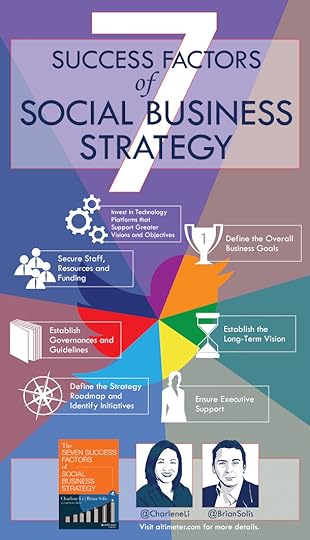
Via Mark Smiciklas…

Connect with me:
Twitter | LinkedIn | Facebook | Google+ |Youtube | Instagram
May 12, 2014
Guiding the Customer Journey
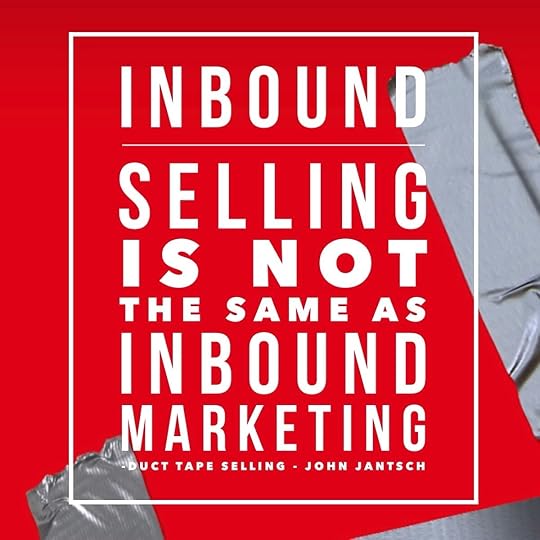
Guest post by John Jantsch is a marketing consultant, speaker and author and the founder of the Duct Tape Marketing Consultant Network. His latest book, Duct Tape Selling – Think Like a Marketer, Sell Like a Superstar is available online and in bookstores May 15.
Just a few years short years ago marketers were still heavily focused on broadcasting their message to create demand for their products and services.
Today, a kinder, gentler form of marketing called inbound marketing relies primarily on the creation and distribution of content in an effort to “be found.”
The foundation of the inbound approach is based to use heaps of content to draw people into you marketing funnel. And, while this has proven effective, many marketers simply interpret this to mean you create more demand by creating more content.
The problem with this thinking is that it’s really just the same old approach polished up with more information.
Today, marketing is about guiding a journey that the buyer wants to take rather than forcing them into the journey that fits our business model.
People don’t really need more information, they need insight, they need guidance and they need an experience that allows them to behave like they want to behave.
So, in many ways the future of marketing is less about creating demand and more about understanding and organizing behavior.
Over the years I’ve identified seven behaviors that most buyers desperately want to experience on their way to becoming loyal customers. Organizations that get this and create and organize opportunities for people to experience these behaviors at any point along the journey will win.
I’ll warn you that the journey is not always as direct and orderly as most marketers would like. Our job as marketers is to help buyers travel an often-crooked path that allows them to:
Know – They want to give permission to the companies they want to know
Like – They want to learn to like and respect companies that might be addressing their needs in a way that makes sense to them
Trust – They want to see that their friends and others they relate to have come to trust certain organizations for a variety of reasons
Try – They want to be able to prove to themselves that buying from certain organization won’t make them look foolish
Buy – They want to discover that there are companies that make the buying experience as awesome as the marketing experience
Repeat – They want to develop ties to organizations they can count on and that allow them to forget about other options
Refer – They want to have such a remarkable experience with organizations that so exceed their expectations they are compelled to share with the world how smart they are
If organization are to address these behaviors, marketing, sales and service must participate as one in guiding the relationship. The traditional silo walls must come down. Sales must participate earlier in the buyer’s journey and stay later. Service must become more social and marketing must learn how to personalize content while bringing front line sales people into the creation of messaging and positioning.
May 8, 2014
ASCAP and the Great Pandora Battle Where Artists and Musicians Pay the Price
Guest post by Monica Corton (@momusing), Executive Vice President, Creative Affairs & Licensing Next Decade Entertainment, Inc.
I spent many hours fielding questions and having conversations with songwriters about the recent win by Pandora in the ASCAP rate court. Mostly, the songwriters wondered why there was a battle in the first place and why ASCAP lost. Performance rights licensing (the right to publicly play/perform a song on the radio, television, the Internet, large venues etc.) is one of those areas that songwriters love, but often know little about. They love that the check comes in the mail on a quarterly basis like a miraculous gift and some even call it “mailbox royalties.” They rely on this money heavily even though many would not be able to describe how it is generated or what the rules are in governing the two major Performance Rights Organizations (PROs), ASCAP and BMI.
The Pandora battle revolves around this governing issue. ASCAP and BMI are membership associations which each represent over a half a million songwriters and music publishers in the field of performance rights licensing. ASCAP and BMI each function under consent decrees entered into with the U.S. Justice Department. The current consent decrees require that ASCAP and BMI must grant a license to any potential company or service that wants one. They do not have the right to say “no” to any potential licensee.
If, after they negotiate with any licensee — in this case, Pandora — and the licensee does not like the rates proposed by ASCAP or BMI, the licensee or the PRO has the right to go to federal court in New York to set the rate. This is exactly the tack that Pandora took and what has led us to this current situation. In court proceedings, it is the PRO’s burden to demonstrate that its proposed rate is “reasonable,” but the consent decrees provide no standards for determining “reasonableness.” The ASCAP Rate Court, through Judge Cote, has been consistently ruling against ASCAP since she began her tenure as the sole judge responsible for setting ASCAP license fees in 2009, rejecting the comparable licenses ASCAP has proffered as benchmarks for gauging the reasonableness of its fee proposals and accepting instead the licenses relied upon by Pandora and other ASCAP licensees.
What is particularly upsetting about all of this is the monetary facts revolving around Pandora. The license that Pandora has been functioning under since it entered into its original agreement in 2005 with ASCAP was at a rate of 1.85% of Annual Revenue, with the combined rate for all of the PROs totaling 4.3% of Annual Revenue. This is slightly more than traditional radio broadcasters pay for their ASCAP licenses, and commensurate with what other streaming services had been paying. However, services like Spotify and the new iTunes Radio pay significantly higher rates, ranging as high as a combined 10% of Annual Revenue. Further, the rate that Pandora pays the record labels for the master rights (the artists recording of a particular song) is in the range of 50% of Annual Revenue. Yes, you read that right….the songwriters have been fighting Pandora for them to pay 4.3% of Annual Revenue when Pandora pays the record labels 50% of Annual Revenue for the use of the master recordings of those same songs.
When Pandora complains that they are paying too much in royalties, which is their constant battle cry, the problem is they are paying a huge rate to the record labels. However, they have no recourse or leverage to reduce the rate they pay to the record labels because the labels function independently and their rates for services like Pandora have been determined by another governmental entity, the Copyright Royalty Board. The only royalties that Pandora has access and leverage to reduce are the songwriter royalties because of the way the consent decrees function.
The court costs that ASCAP has paid in fighting Pandora over their streaming rate come somewhere in the range of $5 to $9 million. Pandora likely has paid equivalent legal costs in their battle. Imagine if Pandora hadn’t gone to court over the combined PRO rate of 4.3% and had put that money — at the low end, say $5 million — into paying music publishers and songwriters a fair rate, the rate other streaming services are paying. Maybe then, Tim Westergren, Pandora’s CEO, who loves telling the press how much he adores musicians and songwriters, could honestly say that he is helping them with his streaming music service rather than what he has truly done, which is to almost single handedly upend the entire structure of the performance rights licensing system.
How did Westergren affect the performance rights licensing structure? The music publishers disagree with Judge Cote’s rate of 1.85% of Annual Revenue. In fact, the music publishers thought the combined PRO rate of 4.3% was also too low. The only way to get a higher rate is to pull the digital rights licensing away from the PROs’ control and make direct deals with digital services. This would allow the music publishers not to be governed by the consent decree in matters dealing with digital performance rights licensing. Some of the major music publishers and independent music publishers were in this process of pulling their digital rights with the PROs and EMI Music Publishing, Sony/ATV Music Publishing and Universal Music Publishing even negotiated direct deals with Pandora as they were the first music publishers to pull their digital rights licensing from the PROs. There had been a six month waiting period before any publisher could pull digital rights from ASCAP or BMI.
This process was moving forward for many publishers and then Pandora went to the ASCAP and BMI rate courts, asking those courts to rule that the publishers’ rights withdrawals did not apply to digital services like Pandora that had applied for licenses under the consent decrees. Both rate court judges ruled that the music publishers could not pull just one set of licensing rights (e.g., digital rights) from either ASCAP or BMI. The judges said if the music publishers wanted to license directly, they would have to pull all performance rights licensing from the PROs. No music publisher wants to do that.
Now, the PROs, the music publishers and others are asking the Department of Justice to agree to change the consent decrees so that it is clear that digital rights licensing can be pulled from the PROs. This will mean all digital companies, including Pandora when its current license is up in 2015, will have to negotiate with multiple music publishing companies either to get their services up and running, or to continue to offer their digital music services, because they won’t be able to clear digital performing rights at the PROs alone if the music publishers withdraw their digital rights. It will add a whole new level of rights clearance issues and liability to the process because the lawyers for these new digital companies will have to engage in these direct deals and ensure that they are covered for all of the music repertoire in their client’s digital services.
Before this rate battle began between ASCAP and Pandora, there was no question that all of the music publishers were being represented by the PROs for digital rights licensing.
The future seems precarious to the music publishing/songwriter community. The BMI rate court has yet to take up the Pandora royalty rate issue. If the PROs and the music publishers are successful in modifying the consent decrees, they will have a business solution for getting a higher rate, but it really isn’t a solution for the health and development of building new digital music companies and services. I firmly believe none of this would be happening if Pandora had been a good player with ASCAP. They created this situation and then Judge Cote complemented their bad moves with a totally unworkable decision.
I was at a publisher meeting recently, and the presenter gave some startling figures. He said that last year, Tim Westergren took out over $15 million dollars in stock options for Pandora (the highest amount he could extract in any given year). At the same time, Pandora paid ASCAP a little over $11 million in royalties for access to the entire ASCAP repertoire for the entire year. If this is true, or even slightly exaggerated then how does the guy who owns Pandora receive millions of dollars more in money in one year than all of the ASCAP songwriters and music publishers whose music was featured on his service in that very same year? When you look at it from this perspective, you can understand why there is such an outcry from the songwriter/music publishing community.
The music publishers and the PROs want a workable solution with Pandora and all the digital companies, but they cannot sit idly by and not receive a fair market value for their songwriter’s works in the digital arena. It’s a wild west in licensing right now, what I find so sad is…. it didn’t have to be.
Photo of Saxophone player by Shutterstock
May 6, 2014
Investing in Social Networks to Earn Influence and Reciprocity
On this special episode of Revolution, we meet Porter Gale, former VP of Marketing of Virgin America, advisor to exciting startups and business ventures, avid speaker, and also the author of the best-selling book, Your Network is Your Net Worth. Porter is someone whom I personally admire and have also had the good fortune to work with over the years.
With Porter, no matter what she’s working on, everything begins and ends with people. She shares her recipe for success in her new book and also with us here.
The idea of measuring the existing and potential value of a brand, or a person for that matter, by the nature and activity of its network or community is fascinating. To me, there are two ways to look at this…1) the net worth of the community as it exists and 2) its valuation based on what it could be. If we measure value based on the network effect of community engagement, often we see how conversations, listening, participation transcend online borders to cause desirable effect or positively change behavior. This only becomes increasingly resonant and effectual the more you invest in it and also focus it.
Everything begins with a shift in perspective. You must have the ability to teach but also the ability to learn. She’s both a mentor and a student. I love that about Porter. As incredible as she is, no matter how much in demand she is, she makes time for her communities. Personally, I could do better in that arena.
Here, Porter shares that the secret to relationships is collaboration…the more sharing, the better the outcome. It’s also equally important to listen. In fact, the best listeners, those that hear and respond in a way that’s empathetic, are among the best conversationalists (and strategists). Why? Because the reward for doing so is reciprocity…and that’s as human as it is priceless.
Please take a moment to watch this episode of Revolution:
Subscribe to BrianSolisTV here.
May 1, 2014
Facebook Evolves from Social Network to Social Ecosystem
Every so often, Facebook hosts its f8, a conference in San Francisco aimed at developers, media, and partners. This year, in front of an audience of 2,500+, Facebook introduced its vision for the next year and beyond. With Mark Zuckerberg kicking things off, Facebook introduced a dozen or so new products organized into three including Facebook’s update to Login, which gives people more control over the information they share with apps, Anonymous login, which offers a way for people to log in to apps without sharing personal information from Facebook with developers, and the Audience Network, which allows advertisers to easily extend their Facebook campaigns into other mobile apps.
The theme of f8 and also Facebook’s intentionally limited vision at the conference focused on three pillars…
1) Build
2) Grow
3) Monetize
The goal was to help developers expedite time to market, amplify visibility in the app world, optimize user experience and increase the value of their apps by plugging into the Facebook ecosystem. And by leveraging (still not used to using this word as a verb) Parse, a mobile app development platform acquired by Facebook in 2013, developers will have an unprecedented springboard toward market acceleration and consumer prevalence.
f8 2014 Announcement Summary
At f8, Facebook’s quantity and quality of announcements was notable. While aimed at developers, the implications of course significantly impact consumers, brands, and advertisers.
Let’s run through the list of Facebook’s news organized by its Build, Grow, Monetize focal point…
Build
The new Facebook Login: Letting people select what information to share with apps
Anonymous Login: A way for people to log in to apps without sharing personal information from Facebook with developers
Improved stability: A two-year stability guarantee for our core developer products
App Links: Making linking between apps easier
Parse updates: We updated Parse pricing to make building apps less expensive, and introduced tools for developers to build apps with Parse that work offline.
Grow
Message Dialog: Letting people share content from apps with friends through Facebook Messenger
Mobile Like Button: Like the Pages or content of individual apps through a native, mobile Like button
FbStart: A new program to help mobile startups grow through a package of resources and tools provided by industry leaders
Send To Mobile: An easy way for people to send an app to their phone after visiting a web site and logging in with Facebook
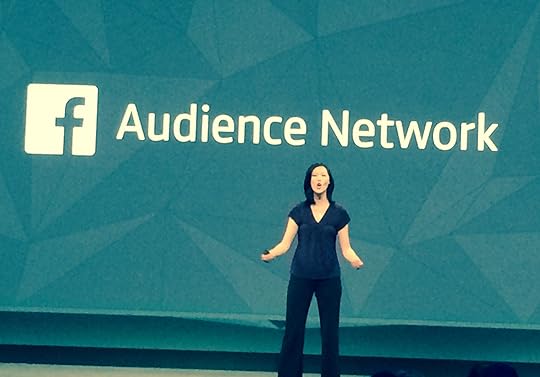
Facebook’s Deborah Liu introduces Audience Network at f8
Monetize
Audience Network: Developers now have a new way to effectively monetize mobile apps
Was f8 a 10?
If you judge success by audience response, the series of cheers and applauds that followed each announcement was certainly encouraging. While each announcement is important in its own right, in aggregate, they represent something far more profound.
The new “big blue” of the social economy has just grown up from a global social network with 1.2 billion users into a full-fledged social ecosystem. As Mark so called it, Facebook aims to build a “cross-platform platform.”
What does that mean?
It’s another way of saying social ecosystem.
What’s that mean?
In simpler terms, it means that Facebook as a platform is becoming incredibly portable and universal in pursuit of ubiquity.
Whether or not people are actually in Facebook at any one moment, with developers building apps upon the network of new tools, Facebook users carry their digital life with them. As a “cross-platform platform,” Mark’s vision is that developers can carry the power and appeal of the social graph seamlessly across IoS, Android, Microsoft, and others.
Take a look at Facebook’s list of new products again and what follows will make even more sense.
What Google search is to AdWords, what surfing and cookies are to ad targeting and re-targeting, Facebook’s social graph and social expressions are emerging as an omniscient index of personal connections and preferences. Now, developers, brands, and anyone with something to say or sell, can find people based on psychographics not just demographics as long as they’re willing to 1) pay Facebook directly or indirectly for it and most importantly 2) think thoughtfully about who it really is that they’re trying to reach and what makes them both unique and well-qualified to hear from you.
In many ways, like Twitter, Facebook is moving toward an Interest Graph and away from a straightforward social graph. Users will not only discover new content, apps, and ads based on who they know but additionally by what they like and express inside and outside of the network. And while that isn’t exactly new, the cloud for which this data resides has now been packaged, productized and presented to the market for experimentation.
Indeed, Facebook is still a social network. That’s its edge of the wedge play.
But the rest of the wedge, and its new revenue generating pillars include:
- Mobile
- Social Data
- Data as a Service
In a way, this is all very 1984. But at the same time, we as users have more control than ever before to fine-tune the signal of content and marketing that finds us. At the same time, to actually reach us, developers and marketers have to rethink their approach to grab our attention, pique our curiosity, and reward us for our time. In turn, we’ll reward our suitors with the very things they value. See, this isn’t just business, it’s personal. This is what sets Facebook apart from Google. It’s a more natural approach using a human algorithm rather than just a sophisticated technological algorithm.
Best of all, what Facebook did well at this year’s f8 was lead by example. With each of the company’s announcements and overall, the company itself demonstrated how to build, grow, and monetize.
Connect with me: Twitter | LinkedIn | Facebook | Google+ |Youtube | Instagram
April 29, 2014
Stop Talking About Technology and Start Designing Experiences
As Joe Pine and Jim Gilmore wrote in the Experience Economy: Work Is Theater & Every Business a Stage, the future of business is less about products and more about creating experiences. That’s right. You’re no longer in the product business. Products are a by-product of experiences you set out to create. Products are also social objects that spark desirable relationships between you and customers and also among customers.
The future of business is experiences.
One year after launching What’s the Future of Business (WTF): Changing the Way Businesses Create Experiences, I had the opportunity to tell the story behind the book and why experiences are…everything. I joined #MMchat hosted by Jeff Ashcroft (@TheSocialCMO), a weekly marketing chat on Twitter dedicated to helping CMOs and senior marketing strategists learn how to change their businesses.
I wanted to share the conversation with you here to reveal a more personal side…the intentions, decisions, and stories behind #WTF:
- Why did I focus on experiences?
- How exactly are experiences the future of business?
- What was my inspiration for designing the book the way I did?
You’ll notice that each question and answer is less than 140 characters…
Question 1: #WTF have you been doing for the past year+? #MMchat
The launch has been equally exhilarating, challenging + insightful. The book has done very well. It’s been a hustle though #MMchat
With each book, it gets harder, not easier, to compete for attention and also my share of $15.
Everyone is so busy these days…competing for mindshare in the moment and the future at the same time is humbling.
Tell us a bit more about #WTF. What was the inspiration for the book?
I am fascinated by experiences and how in a connected world, it is shared experiences that define our relationships.
I believe that shared experiences are driven from emotion and less about transactions.
Engagement is about creating experiences. Experiences are about expressions and not impressions. What should ppl feel and say?
I wanted to write a book that was an experience to demonstrate the purpose and possibility of being thoughtful at a higher level.
I set out to make a print book matter in a digital economy. I studied UX + was really thoughtful about the message I wanted to send.
The result…#WTF became an analog app where print is now arguably more effective than its digital counterpart.
If I could do this for a book, imagine what you can do with your product, service, or company.
Curious, does a book that’s been out for a year seem old in a digital economy?
Yes and no. A book takes time to produce. It’s not part of the real-time world we live in. It’s part of slow media.
I try to write books that are timeless-regardless of tech or trends. But even posts I wrote 6 weeks ago are “oldies but goodies.”
I wish I could take away the dates of my greatest works. People automatically think they’re old when they’re still the best.
I love book’s title. Tell us the story behind it, how you came up with #WTF & how you got that on the cover!
My last book was The End of Business as Usual. What’s the Future is about “what’s next.” half-empty vs half-full.
The fun part though is that “What’s the Future…” was intentional so that I could use the #WTF acronym 
Getting #WTF on the cover was easier than I thought. @WileyBiz was very supportive. You’ll notice it’s muted on the cover though.
The subtitle is very provocative, ‘Changing the way businesses create experiences.’ Why experiences?
Experience is everything. We think too much about products, services, brands, and transactions. We often miss what people feel!
We need to create experiences. Start with what people should feel…think…share. The future of branding is experience architecture.
In the book, you focus on the MOTs (The Moments of Truth). You claim there are 4. Can you walk us through the first moment?
The Zero Moment of Truth aka ZMOT is what Google introd as that moment when someone enters the discovery. Here they “Google it”
What happens in a world when Google isn’t the 1stst step in ZMOT? What if you YouTube or a review site is first? That day is here.
In a world of shared experiences, I’d take videos vs. websites. Websites suck on mobile phones.
Besides…Websites are written for execs who approve copy & not written for customers in their language or for their context/intentions :/
I want to hear from real people like me with real experience that match my intentions not marketers or spokespeople. #amiright?
In #WTF, you introduce the UMOT, The Ultimate Moment of Truth. Please share what it is and why it’s important.
The First Moment of Truth (FMOT) and the Second (SMOT) deserve a mention. FMOT = when someone is *about* to make purchase.
SMOT=the experience someone has when they become a customer. Experiences never end though. Experiences last throughout the lifecycle.
The Ultimate Moment of Truth (UMOT) is that moment when someone shares their experience.
UMOT is the future of branding. People already share today but they do so without our influence.
UMOT = the next person’s ZMOT. Shared experiences are the expressions that define the impressions and actions of other customers.
Something key to remember though is that we tend to confuse #connectedcustomers with ourselves. We project our actions upon them.
In many ways we are AND are not our customers. Yet we make decisions+investments as if we “get” them. Much is counter intuitive.
Just because you do something a certain way doesn’t make it “the” way. Same is true for execs who see things differently.
In my research, I’ve found that the next step leads to #digitaltransformation. “What would my digital customer do?”
You can download my latest research on #digitaltransformation here.
It’s our time to define the experience we want people to have and then share and reinforce it in all we do, say and create.
You can read the entire Twitter transcript here.
Connect with me: Twitter | LinkedIn | Facebook | Google+ |Youtube | Instagram
Image Credit: Shutterstock
April 24, 2014
Curiosity Didn’t Kill the Cat, It Unleashed a Lion: Cultivating Tomorrow’s Leaders Today
Guest post by social impact journalist and filmmaker Melissa Jun Rowley (@MelissaRowley), creator of the upcoming series “Magic Makers.”
Earlier this week, I was talking with a friend of mine who sold a fashion tech company in the early 2000s — before social media spawned copycat startups left and right, before TechCrunch made rockstars out of hot, young founders, and before corporations were seeking new ways to engage customers as forever faithful, digital brand ambassadors.
“There are times when I feel like I’m really putting myself out there, and taking a leap, but in hindsight I’m merely taking baby steps and trying to take calculated risks, so calculated that they’re not even risks,” I shared. “I’m basically playing it safe.”
“Unless you’re walking through a dark alley filled with killer monsters, playing it safe is the dumbest thing you can do,” she said. “If you’re really curious about something, you can’t pussyfoot around the water. You have to dive in.”
Her words struck a sharp chord with me, and got me thinking about the people I admire most—the ones out there taking risks, daring to innovate with the intention of changing consumer habits, and dancing like no one is watching. Most of them are between the ages 14 and 19.
This isn’t coincidental. Teenagers today are different than Millennials and older generations. Teens have never known a time before the Internet. Growing up amid significant tech innovation and political revolutions unfolding via social media, teenagers are are exceptionally globally aware and they are constantly asking questions. Not only are they asking questions, they’re creating solutions.
About a year ago, I read a story about a 16-year-old boy who invented a noninvasive, inexpensive way to detect pancreatic cancer. His name is Jack Andraka. His invention is 100 percent accurate. Jack introduced me to Adora Svitak. At 16, she’s already an accomplished author and activist. When she was 12, she spoke at TED about what adults can learn from kids. A few weeks later, I met a 17-year-old by the name of Easton LaChapelle. Easton used a 3D printer in his bedroom to build a robotic prosthetic arm designed to be controlled by brainwaves.
Later, I met Mariah Reyes, a dream interpreter who started a clothing line from recycled trash. I asked to share her greatest passion with me and she said, “As a country we’re going through a collective shadow, a collective fear that confines us from doing what we really want to do, and from becoming who we really came here to be. But we can come together and be a community. We can be demonstrators. We can think, declare and manifest change.” She’s 16 years old.
Not only are these young people prime examples of the most informed, connected generation in history, they are unabashedly, unequivocally unafraid to fail, which is why they’re so original. These kids think and they play. They collaborate, and they come up with good ideas just crazy and imaginative enough to work. They take risks. They don’t know any other way doing things.
This kind of human ingenuity is of the utmost importance to the fabric of our society for multiple reasons. In 1970, the top three skills required by the Fortune 500 were reading, writing and arithmetic. In 1999 the top three skills in demand were teamwork, problem-solving and interpersonal communication. We need schools to develop these skills in young people, and we need educators to encourage curiosity and risk taking so this mindset will ultimately transfer to businesses.
That being said, there is a new generation of educators who are inventing ways for students to learn through their own curiosity. Rather than spoon-feeding information, these teachers are prompting students and then stepping aside so the students can teach themselves, while discovering their own unique talents. There are high schools in New York City that do this. They’re a part of the Internationals Network, and they report a higher graduation rate than the city’s average for the same populations.
What would happen if more businesses took this cue? What if more brands created space for creating new products and influencing behavior? Not every company can have a Google X, creating future technologies such as space elevators and self-driving cars. But the brands that continue trotting on a safe terrain will never reach a higher plateau.
At the end of the day teenagers are young. They still have all of their dreams in front of them. They don’t have all the answers any more than any other age group. But it’s time we ask them to be a bigger part of the conversation about improving business and global development, so they can help us build solutions.
Image Credit: Shutterstock


